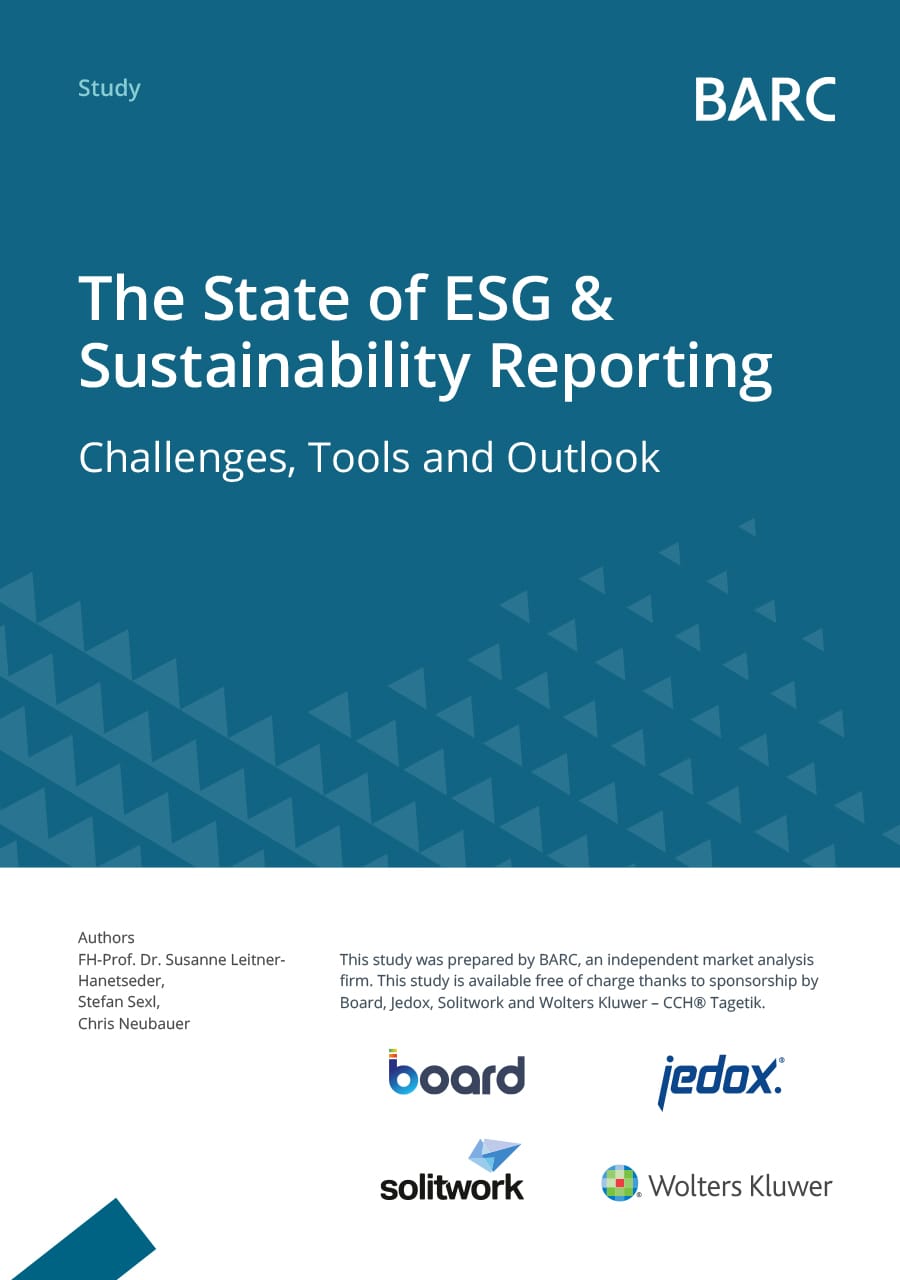
Navigating ESG data management in a complex world
As environmental, social, and governance (ESG) becomes an increasingly important initiative for customers, stakeholders, and regulatory authorities worldwide, finance teams shift their focus to collecting and reporting on ESG data. To accomplish this, they need to identify which information is essential to meeting standards and then develop a system for collecting it from multiple sources. However, the fragmented state of ESG data – and the fact that most of this data is collected manually – complicates the task, demanding additional time and resources to find a resolution.
Reconciling complex data, ensuring auditability, and keeping up with evolving standards is a tremendous undertaking. This underscores the need for finance teams to develop a strategy for incorporating ESG into their financial planning and reporting activities and find solutions that help them on their journey.
Understanding ESG data complexities
One of the first ESG challenges that financial planning and analysis (FP&A) managers encounter is the sheer volume of data. The data tends to be dispersed across different departments, software applications, and spreadsheets, leading to operational inefficiencies and data silos. As a result, achieving a comprehensive view of an organization’s ESG performance becomes all but impossible.
Compounding this challenge is the absence of standardization. Organizations frequently lack a standardized process, and reporting is mostly manual, according to PwC research.1 This means that finance teams must work with chief executive officers (CFOs) to define a set of relevant ESG metrics and proactively determine what information to report, how to source it, and who the key stakeholders are.
On top of that, data accuracy is paramount as ESG reporting faces increasing scrutiny from various stakeholders. Inaccuracies can undermine trust among investors, cause adverse repercussions from regulatory authorities, and erode public confidence. Therefore, validation processes and robust audit capabilities are crucial components of ESG data collection, ensuring that the reported metrics are a true reflection of the organization’s social performance.
Important ESG data and KPIs
In the ever-evolving landscape of ESG reporting, legislation plays a pivotal role in shaping which metrics organizations must report and when – and this is not a one-size-fits-all scenario. The requirements can vary based on both geography and an organization’s size and type. With this complexity, the concept of “double materiality” takes center stage, highlighting the need for organizations to define their own priorities and key performance indicators (KPIs). It is a delicate balance of considering both an inside-out perspective, focusing on the internal impacts and initiatives, and an outside-in perspective, accounting for the external expectations and impacts.
In the ever-expanding universe of ESG reporting, harmonization of financial and ESG KPIs emerges as a critical imperative. Harmonized KPIs not only enhance transparency but also enable businesses to show their commitment to ESG initiatives consistently and credibly. However, ESG data is highly varied and originates from various departments within the organization:
Environmental data
Environmental data often encompasses non-financial information that was never previously tracked, such as energy conservation efforts, employee commuting behaviors, office carbon footprint, and paperless initiatives.
Social data
Metrics focused on diversity and inclusion, employee well-being, and labor practices often originate from human resource (HR) systems. The challenge arises from differences in terminology and data structures between finance and HR.
Governance data
Governance metrics encompass a wide range of policies and departments and are essential to ensure that ESG initiatives translate into concrete action.2 For example, finance must collaborate with IT and legal teams to report on data privacy practices, and work with HR to report on incentive structures.
To navigate this intricate terrain successfully, documenting the process becomes paramount. By systematically defining their organization’s unique priorities and KPIs, finance teams can not only fulfill their reporting obligations but also align sustainability efforts with corporate values and stakeholder expectations, driving meaningful change.
Achieving ESG compliance
The pressure to meet regulatory deadlines and adapt to evolving standards is a persistent challenge. Regulations such as the European Commission’s Corporate Sustainability Reporting Directive (CSRD), the increasing prominence of International Financial Reporting Standards (IFRS), and the Global Reporting Initiative (GRI) in the Americas exemplify this dynamic landscape. California’s recent bill adds to this complexity, mandating emissions reporting by January 1, 2025, with public disclosure requirements for scope 1 and 2 emissions beginning in 2026, followed by scope 3 emissions in 2027.
Within this context, FP&A managers face the dual responsibility of collecting and managing ESG data while ensuring compliance. Demonstrating a commitment to ESG principles is increasingly seen as essential for those doing business in the European market, similar to the way General Data Protection Regulation (GDPR) compliance has become a prerequisite.
The benefits of automation for ESG
Implementing automated technology for ESG data management can provide organizations with multiple benefits. Automation streamlines the process, significantly reducing the time spent on manual entry and report generation. This increases accuracy and ensures that information is always up to date, helping finance teams measure progress against sustainability goals more effectively. Additionally, automation enables organizations to integrate ESG data into financial planning systems so they can align on overarching business goals.
Not only does automation make ESG data management more efficient, but it also helps organizations comply with existing regulations by creating automated processes for tracking relevant KPIs and emerging standards. Additionally, automated technology provides real-time insights into operations, which allows organizations to make prompt decisions in response to changing customer demands and business conditions. Therefore, investing in automating these processes early will future-proof the organization for sustainable success.
Simplifying ESG data management
The growing demand for ESG data poses a significant challenge, particularly in the context of supply chain emissions. Many organizations encounter difficulties in gathering actionable data, particularly when it comes to supply chain emissions, leading to fragmented reporting. Financial expertise can play a pivotal role in addressing this issue by promoting standardization across data sources, metric definitions, and overall data collection policies and procedures. Leveraging existing financial reporting tools and automation methods, while investing in employee upskilling, can help streamline reporting and analysis.1
Initiating the process by inventorying and aggregating ESG information is a critical first step. According to EY research, 60% of finance professionals say that ESG information is scattered across multiple software applications, and 55% house their ESG data in spreadsheets.3 Finance teams can take steps to bring order to this data collection process, leveraging technological advancements and the development of standardized reporting systems to simplify the process.
Centralizing ESG data with Jedox
FP&A’s role in ESG reporting is a natural fit. For example, finance must be able to integrate large volumes of data, such as carbon emissions, environmental impacts of company operations, and strategic workforce planning, to name a few. This presents a challenge without advanced processes for data gathering.
Jedox ESG reporting software centralizes data from various sources, creating a single source of truth for ESG reporting. This includes not only quantitative data but also qualitative information. By blending actuals, budgets, forecasts, and targets, Jedox empowers teams to plan, report, and drive ESG performance effectively.
Empower finance
The office of finance already possesses expertise in combining datasets and shaping KPIs. Jedox leverages this knowledge to streamline ESG reporting. With extensive experience in connecting with other departments, such as HR and diversity, Jedox aligns existing initiatives with ESG reporting needs.
Harmonize KPIs
Jedox helps harmonize financial and non-financial KPIs, which have gained prominence. By applying best practices across the organization and integrating data from various sources, Jedox ensures a unified and efficient ESG reporting process.
Include evolving standards
The ESG landscape is evolving rapidly. Standards are in flux, and the legislation is constantly defining new reporting requirements. Jedox allows finance teams to adapt to these changes quickly. Define priorities and KPIs based on the organization’s unique needs, taking both an inside-out and an outside-in perspective. Documenting this process ensures transparency and compliance.
Ensure data quality
Data quality is paramount in ESG reporting. Jedox assists in validations and offers a unique opportunity for peer group validations. By benchmarking data against similar organizations, teams can identify gaps and improve the data collection process. Learning from industry peers can be invaluable in enhancing the accuracy and reliability of your ESG data.
Achieve holistic planning
Jedox creates a digital twin of the organization, enabling accurate analysis and prediction of ESG impacts and proactive decision-making. With this comprehensive view, teams can establish targets, allocate responsibilities, and effectively bridge the gap between current performance and their goals, ensuring that ESG reporting isn’t just a retrospective exercise but an active strategy for a sustainable future.
Boost collaboration
Collaboration with stakeholders outside of finance is crucial for successful ESG reporting. FP&A managers will need to distribute ESG metrics across the organization and gather input from various business units. At the same time, these business units must be able to input their own ESG targets and goals. Traditional methods, such as emailing spreadsheets, are inefficient. Jedox centralizes ESG and financial metrics, enabling real-time performance insights and collaboration. Doing so allows organizations to immediately visualize the impact of changes across the business and adjust when obstacles arise.
Conclusion
The future belongs to those who can harmonize financial expertise and ESG stewardship. Embracing ESG reporting transcends mere compliance; it signifies an opportunity for finance teams to transform their organization’s approach to ESG data collection. By taking proactive steps in ESG data management, finance teams can craft a strategy that not only ensures short-term compliance but also fosters long-term success. This involves KPI monitoring, integrating ESG metrics into overarching financial objectives, and adopting a cohesive strategy. In this transformative journey, finance teams are uniquely positioned to guide the transition from early ESG reporting to a more mature, structured, automated, and consistently governed process.
Jedox simplifies ESG data management, enabling teams to meet the evolving expectations of regulators, stakeholders, and their own sustainability objectives with confidence. Request a live demo today.
Sources
1 PwC, Human capital disclosures are key components of your ESG reporting strategy
2 World Economic Forum, Defining the ‘G’ in ESG: Governance factors at the heart of sustainable business, June 2023
3 EY, How finance professionals are helping to advance ESG reporting, May 2022




